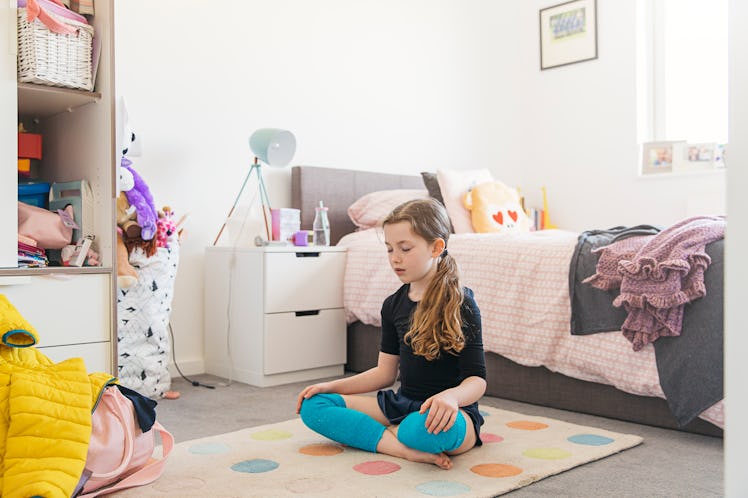Breathing Exercises For Kids: Everything Parents Need To Know
Nobody can think straight mid-tantrum. These breathing exercises can help.

When kids are mid-tantrum, cortisol surges throughout their body, making them act out of instinct rather than intention. That’s part of the fight-or-flight response — an evolutionary biological response that enables us to face dangerous situations. The cure? Take a deep breath. That sounds like a useless platitude. It’s not. Research shows that there are real benefits to the age-old advice of taking a deep breath. Breathing exercises for kids can be a powerful tool in any family’s behavioral toolbox.
How Deep Breaths Work
We tend to think of feelings as abstract, but getting upset has tangible, measurable effects on our body. When we’re stressed, adrenaline and cortisol flood through the body. The heart starts beating faster, fat and sugar are sent to the bloodstream to provide accessible energy, and our senses become sharper. When anxious, we tend to take more frequent breaths, which increases the amount of carbon dioxide in the body. Blood vessels respond by constricting, limiting blood flow to organs and tissues, and causing blood pressure to drop. This lack of blood flow is to blame for the numb or tingling feeling some people get during panic attacks.
Slow, deep breaths reverse these processes. The measured inhale and exhale helps restore the body’s carbon dioxide levels, turns off the fight-or-flight response, and helps put the body at rest. Research shows that deep breathing exercises reduce anxiety and pain in children and even improves their test performance.
When to Take a Breath
In practice, Umakanth Katwa, M.D., a pulmonologist and director of the Sleep Laboratory Boston Children’s Hospital, says he’s had patients use regular breathing exercises to come off of anxiety medication.
Katwa says it’s important to practice deep breathing regularly, not only in moments of distress. “Kids who are anxious at baseline can easily fall into panic attacks. They are already at the edge, and when something kicks in, they suddenly start hyperventilating,” Katwa says. “You practice every day, you slow breathe every day, even when you’re not anxious, and then even though you become a little bit anxious, you have the bandwidth to not fall off the edge.”
Practicing Deep Breaths
To start, Katawa tells patients to close their mouths. Breathing through the nose automatically forces you to slow down, take longer breaths, and use the diaphragm. Parents can watch a child’s belly to tell whether they’re doing deep breathing. If their chest is moving, they’re likely taking shallow breaths.
Practice deep breathing regularly, two to three times per day, not only in moments of distress. This helps build the habit so that kids remember to do it when they’re freaking out.
Important caveat: If a child has a breathing disorder, like asthma, or you suspect they do, consult your doctor for a more personalized recommendation. And proceed with caution for children under five, which is the earliest age when children are typically given asthma diagnoses.
10 Breathing Exercises for Kids
Breathing doesn’t have to be something a kid does every day unconsciously. In fact, bringing some mindfulness and play to their breaths can help them focus and prepare for those moment when a deep breath will bring them back to baseline. There’s no need for breathing practice to be boring when you get imagination into the game.
Box Breathing: Inhale for four counts, hold your breath for four counts, exhale for four counts, and hold again for four more counts.
Bumble Bee Breathing: Inhale slowly, then exhale while making a “bzzzz” sound for as long as you can.
Balloon Breathing: Place a hand on your belly, imagining that it’s a deflated balloon. Inhale, visualizing your belly balloon filling with air, and notice as your hand and belly rise. Gently hold your breath for two counts, then exhale, slowly deflating your belly balloon.
Swimming Breathing: Visualize swimming under and over the water. Lift your arms over your head as you inhale, as though you’re coming up and out of the water for air, then dive back in, bring your hands back to your sides and slightly behind you while exhaling.
Rainbow Breathing: Imagine a rainbow in front of you. Trace your finger from left to right as you inhale, and then right to left as you exhale.
Lazy Eight Breathing: Trace a finger in the air in the shape of an eight as you inhale, repeat the opposite way as you exhale.
Roller Coaster Breathing: Hold out one hand in front of you so that you’re looking at your palm. With the other hand, trace around each finger, inhaling as you move up a finger to its tip, and exhaling as you move down a finger towards the palm.
Hot Cocoa Breathing: Hold an imaginary mug of hot cocoa in your hand. Inhale, breathing in the chocolate scent, and exhale, blowing on the steam to cool it down.
Bunny Breathing: Take three quick inhales, sniffing like a bunny, then one long exhale.
Fish Breathing: Inhale through the nose for five, filling the cheeks with air, and then blow out the air through the mouth
The Best Breathing Exercise Supports
Practice helps, but products can help too. These supports can help kids learn and practice deep breathing so it become an even more essential part of their behavioral toolkit.
Every product on Fatherly is independently selected by our editors, writers, and experts. If you click a link on our site and buy something, we may earn an affiliate commission.
This article was originally published on